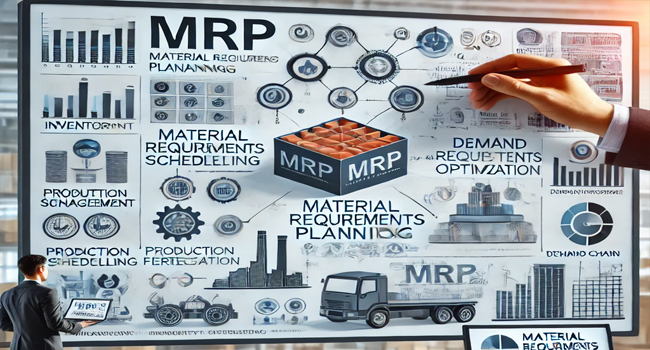Material Requirements Planning (MRP): Meaning and Importance
Introduction
Material Requirements Planning (MRP) is a vital system used in manufacturing and inventory management to ensure the right materials are available at the right time for production. It helps businesses optimize inventory levels, reduce waste, and improve production efficiency. This article explores the meaning, key components, benefits, and real-world applications of MRP.
What is Material Requirements Planning (MRP)?
Definition
Material Requirements Planning (MRP) is a computerized inventory management and production planning system that ensures materials and components are available for manufacturing when needed. It is primarily used by manufacturers to manage supply chain activities efficiently.
Objectives of MRP
- Ensure materials are available for production.
- Maintain the lowest possible material and product levels in inventory.
- Plan manufacturing activities, delivery schedules, and purchasing activities.
How MRP Works
MRP calculates the materials required for production based on the bill of materials (BOM), inventory levels, and production schedules. It generates purchase and work orders to meet production demands while minimizing excess inventory.
Key Components of MRP
| Component | Description |
|---|---|
| Bill of Materials (BOM) | A comprehensive list of raw materials, components, and sub-assemblies needed for production. |
| Inventory Records | A database that tracks raw materials, work-in-progress, and finished goods inventory levels. |
| Master Production Schedule (MPS) | A detailed plan specifying what products need to be manufactured and when. |
| Lead Time | The time required to procure materials and manufacture the final product. |
| Work Orders & Purchase Orders | Documents generated to initiate production and procurement processes. |
| Capacity Planning | Ensures that production resources such as labor and machinery are available when needed. |
Benefits of MRP
1. Inventory Optimization
MRP helps manufacturers maintain optimal inventory levels, reducing waste and storage costs.
2. Improved Production Efficiency
By ensuring materials are available when needed, MRP minimizes production delays and downtime.
3. Cost Reduction
With better planning, businesses can reduce material shortages, overstocking, and expedite costs.
4. Better Customer Satisfaction
Timely production leads to on-time delivery, enhancing customer trust and satisfaction.
5. Enhanced Decision-Making
MRP provides real-time insights into material availability, production schedules, and demand forecasting.
Types of MRP Systems
1. MRP I (Traditional MRP)
Focuses on inventory management and material planning, ensuring materials are available for production.
2. MRP II (Manufacturing Resource Planning)
An advanced version of MRP I that includes additional functionalities such as capacity planning, labor scheduling, and financial management.
3. ERP-Based MRP
Integrated with Enterprise Resource Planning (ERP) systems to provide a holistic view of business operations, including finance, HR, and supply chain.
MRP Process Flow
| Step | Description |
|---|---|
| Step 1 | Collecting data from the Bill of Materials (BOM) and inventory records. |
| Step 2 | Analyzing the Master Production Schedule (MPS) to determine material requirements. |
| Step 3 | Calculating net material requirements by considering existing inventory and lead times. |
| Step 4 | Generating purchase and work orders to procure materials and initiate production. |
| Step 5 | Monitoring and updating records to ensure smooth production and minimal disruptions. |
Challenges of MRP Implementation
1. Data Accuracy
MRP relies on accurate data; incorrect inventory records or BOM errors can lead to production issues.
2. Complexity
Implementing an MRP system requires proper training and integration with existing processes.
3. High Initial Costs
The cost of MRP software and training can be high, making it challenging for small businesses to adopt.
4. Dependency on Supplier Performance
Delays in material delivery can impact production schedules and customer commitments.
Examples of MRP Software
| Software | Best For | Key Features | Pricing |
|---|---|---|---|
| SAP Business One | Medium to large manufacturers | Inventory tracking, BOM management, real-time analytics | Custom Pricing |
| Oracle NetSuite MRP | Growing businesses | Demand forecasting, work order management, supplier collaboration | Quote-based |
| Microsoft Dynamics 365 Supply Chain Management | Enterprises | AI-driven demand planning, automation, cloud integration | Custom Pricing |
| Fishbowl Manufacturing | Small to mid-sized businesses | Inventory optimization, production tracking, QuickBooks integration | Starts at £3,500 |
| MRPeasy | Small manufacturers | Cloud-based, easy-to-use, cost-effective | Starts at £49/user/month |
How to Choose the Right MRP System
1. Assess Business Needs
Identify the specific challenges your business faces in inventory and production planning.
2. Consider Integration Capabilities
Choose a system that integrates seamlessly with your existing ERP, accounting, or supply chain software.
3. Evaluate Scalability
Ensure the MRP system can grow with your business and accommodate future expansions.
4. Check User-Friendliness
A complex system can lead to operational inefficiencies; opt for an intuitive and easy-to-use interface.
5. Compare Pricing and Support
Look for a solution that offers good customer support, training, and cost-effective licensing options.
Future Trends in MRP
1. AI & Machine Learning in MRP
AI-driven demand forecasting and predictive analytics will improve accuracy and efficiency.
2. Cloud-Based MRP Solutions
More businesses are adopting cloud-based MRP for flexibility and remote accessibility.
3. IoT & Smart Manufacturing
IoT-enabled devices will enhance real-time tracking of inventory and production status.
4. Integration with Blockchain
Blockchain technology will improve supply chain transparency and security.
Conclusion
Material Requirements Planning (MRP) is an essential system for manufacturers looking to optimize inventory, improve production efficiency, and reduce costs. By understanding its key components, benefits, and challenges, businesses can implement an MRP system that aligns with their operational goals. With advancements in AI, IoT, and cloud computing, MRP solutions will continue to evolve, providing smarter and more efficient ways to manage production processes.
